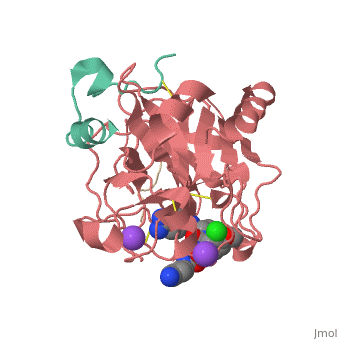3utu
From Proteopedia
High affinity inhibitor of human thrombin
Structural highlights
DiseaseTHRB_HUMAN Defects in F2 are the cause of factor II deficiency (FA2D) [MIM:613679. It is a very rare blood coagulation disorder characterized by mucocutaneous bleeding symptoms. The severity of the bleeding manifestations correlates with blood factor II levels.[1] [2] [3] [4] [5] [6] [7] [8] [9] [10] [11] [12] Genetic variations in F2 may be a cause of susceptibility to ischemic stroke (ISCHSTR) [MIM:601367; also known as cerebrovascular accident or cerebral infarction. A stroke is an acute neurologic event leading to death of neural tissue of the brain and resulting in loss of motor, sensory and/or cognitive function. Ischemic strokes, resulting from vascular occlusion, is considered to be a highly complex disease consisting of a group of heterogeneous disorders with multiple genetic and environmental risk factors.[13] Defects in F2 are the cause of thrombophilia due to thrombin defect (THPH1) [MIM:188050. It is a multifactorial disorder of hemostasis characterized by abnormal platelet aggregation in response to various agents and recurrent thrombi formation. Note=A common genetic variation in the 3-prime untranslated region of the prothrombin gene is associated with elevated plasma prothrombin levels and an increased risk of venous thrombosis. Defects in F2 are associated with susceptibility to pregnancy loss, recurrent, type 2 (RPRGL2) [MIM:614390. A common complication of pregnancy, resulting in spontaneous abortion before the fetus has reached viability. The term includes all miscarriages from the time of conception until 24 weeks of gestation. Recurrent pregnancy loss is defined as 3 or more consecutive spontaneous abortions.[14] FunctionTHRB_HUMAN Thrombin, which cleaves bonds after Arg and Lys, converts fibrinogen to fibrin and activates factors V, VII, VIII, XIII, and, in complex with thrombomodulin, protein C. Functions in blood homeostasis, inflammation and wound healing.[15] Publication Abstract from PubMedDuring extracorporeal circulation, when blood comes in contact with artificial surfaces, patients receive a standard treatment with anticoagulants to avoid blood coagulation. Dialysis patients in particular are systemically treated with heparin up to four times a week, causing a high burden for the body. For potential anticoagulant modification of external materials, such as dialysis equipment, a series of highly potent thrombin inhibitors was developed. All inhibitors share the general formula arylsulfonyl-P3-Pro-4-amidinobenzylamide, where P3 is glycyl or a trifunctional amino acid residue in L-configuration. Among this series, several derivatives inhibit thrombin with K(i) values of less than 1 nM. Specificity measurements revealed that this inhibitor type is highly specific for thrombin with negligible activity against related trypsin-like serine proteases. X-ray analysis of the most potent analogue in complex with thrombin demonstrated that the N-terminal arylsulfonyl group occupies the aryl binding site, whereas the P3 side chain is directed into the solvent and therefore is well suited for further coupling. Based on their in vitro profile, these inhibitors are suitable candidates for the development of hemocompatible materials with anticoagulant properties. Beyond Heparinization: Design of Highly Potent Thrombin Inhibitors Suitable for Surface Coupling.,Steinmetzer T, Baum B, Biela A, Klebe G, Nowak G, Bucha E ChemMedChem. 2012 Aug 20. doi: 10.1002/cmdc.201200292. PMID:22907907[16] From MEDLINE®/PubMed®, a database of the U.S. National Library of Medicine. See AlsoReferences
| ||||||||||||||||||||

